What is it: Digital Technique for Composite Resin Removal
The digital technique for composite resin removal is an advanced dental procedure that uses digital technology to remove composite resins precisely and efficiently. This technique is especially useful in cases where it is necessary to remove old or unwanted composite resins, either to replace them with new restorations or to correct aesthetic problems.
How does the digital technique for removing composite resin work?
The digital technique for removing composite resin uses a device called a high-powered laser, which emits a highly concentrated beam of light directed at the area to be treated. This beam of light is capable of breaking down the molecules of the composite resin, allowing it to be removed in a precise and controlled manner.
In addition to the laser, the digital technique also involves the use of an intraoral scanner, which is a device that captures three-dimensional images of the patient's mouth. These images are processed by specialized software, which allows the dentist to accurately visualize the area to be treated and plan the procedure for removing the composite resin.
What are the advantages of the digital technique for composite resin removal?
The digital technique for removing composite resin offers several advantages over traditional removal methods. One of the main advantages is the precision of the procedure, which allows the dentist to remove only the unwanted composite resin, preserving as much of the healthy tooth structure as possible.
Furthermore, the digital technique is less invasive and causes less discomfort to the patient, as it does not require the use of drills or sharp instruments. The high-power laser used in the technique is capable of removing the composite resin in a gentle and controlled manner, without damaging the tooth or causing pain.
Another advantage of the digital technique is the speed of the procedure. The use of the intraoral scanner and specialized software allows the dentist to plan the treatment accurately and efficiently, reducing the time needed to remove the composite resin.
What are the applications of the digital technique for composite resin removal?
The digital technique for removing composite resin can be applied in a variety of clinical situations. It is especially useful in cases of replacing old restorations, where it is necessary to remove the old composite resin in order to place a new restoration.
In addition, the digital technique can also be used to correct aesthetic problems, such as stains or discoloration in composite resin restorations. The high-power laser used in the technique is capable of removing the surface layers of the composite resin, revealing a more aesthetic and natural restoration.
What care is needed after removing composite resin?
After composite resin removal, it is important that the patient follows the dentist's instructions to ensure a good recovery and avoid complications. It is common for the dentist to recommend the use of a specific toothpaste for sensitive teeth, as the removal of composite resin can leave the tooth temporarily sensitive.
It is also important to avoid very hot or very cold foods and drinks in the first few days after the procedure, as the tooth may be more sensitive during this period. In addition, the patient should avoid biting hard foods or picking up objects with their teeth, to prevent damage to the restoration.
Conclusion
The digital technique for composite resin removal is an advanced and efficient option for removing unwanted composite resins. It offers advantages such as precision, speed and less discomfort to the patient. However, it is important that the procedure is performed by a specialized dentist and that the patient follows the post-treatment guidelines to ensure a good recovery.


